6.3 Protecting your hardware
|
Previous
Chapter 5: Hardware, software and computer management
|
Next
Chapter 7: Networks and internet technologies
|
 CHAPTER OVERVIEW
CHAPTER OVERVIEW
| Unit 6.1 | Input and output devices for physically challenged users |
| Unit 6.2 | Health issues due to input and output devices |
| Unit 6.3 | Protecting your hardware |
| Unit 6.4 | Power supply and settings |
 By the end of this chapter, you will be able to:
By the end of this chapter, you will be able to:
- Identify input and output devices for physically challenged users
- Discuss the health issues caused by input and output devices
- Describe how to protect your hardware from theft and damage
INTRODUCTION
This chapter will focus on input and output devices for physically challenged users, the health issues associated with hardware devices, how to protect your devices from theft or damage and how to protect your devices from power surges and power failures.
UNIT
6.1 Input and output devices for physically challenged users
INPUT DEVICES
The author of A Brief History of Time, famous scientist Stephen Hawking, was diagnosed with a disease called amyotrophic lateral sclerosis (ALS) in 1963 and given only two years to live. He would go on to live for 55 more years (until his death in 2018), but the ALS would cause him to lose the ability to control his muscle movements. An operation done in 1985 to save his life left him unable to speak.

A Brief History of Time was written using two things, a piece of software called Equalizer that took Professor Hawking’s eye movements and translated them into words, and a sensor in his glasses that could track those eye movements. With the help of this technology, a person who would not have been able to use normal computer equipment was able to create ground-breaking work.
There are a variety of alternative input devices available to physically challenged users. These range from fairly common and easy-to-implement adaptations to traditional input devices, to more specialised devices. Next, some of these devices and their advantages and disadvantages are discussed.
INPUT DEVICES FOR PHYSICALLY CHALLENGED USERS
Many options are available to help people who are physically challenged when using ICT. These are just a few devices that could be used.
- Braille keyboard and Braille display device: These are keyboards with Braille lettering, that can be used by blind or visually impaired users.
- On-screen or virtual keyboards: The keyboard is displayed on a user’s screen and used with gesture-controlled pointers or joysticks.
- Microphones: Are used with speech recognition software, allowing the user to dictate their input to the computer.
- Keyguards: Metal or plastic plates that allow a user to rest his/her hands on a keyboard without accidentally pressing the keys.
- Head-mounted pointers: These are controlled by switches to simulate the function of a mouse. The switches can be in hand or foot pads, or pedals or sensors that detect eye movement or facial expressions.
- Gesture-recognition devices: The device recognises hand gestures, head or eye movements, or read lips or sign language to input information into a computer.
- Sip-and-puff devices: A switch that operates the computer when users breathe into (puffing) or through (sipping) special tubes. Special software is used to interpret the sips and puffs and turn them into data that the computer can use.
- Magnification devices: Enlarges the information displayed on the computer screen in a range of magnifications and a variety of fonts. The magnifier may have the ability to create a large, scrolling virtual screen, or may only magnify the portion of the display near the mouse pointer.
- Large-key keyboards: The print on the number and letter keys of the keyboard are three times larger than those on standard keyboards. The bright white printing on the large black keys increases visibility and the contrast makes it easier to read. These features are helpful to those with vision impairment and for those who wear reading glasses or bifocals, or work in low-lit areas.
- Braille printers: These printers operate by embossing raised braille dots onto Braille paper. Pins are pressed into one side of the paper in order to create raised dots on the other side. This is only output.

Braille keyboard

On-screen or virtual keyboards

Microphones

Keyguards

Head-mounted pointers
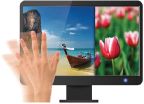
Gesture-recognition devices

Sip-and-puff devices
Keyboard and mouse settings can also be customised to make input easier for physically challenged users. Sticky keys allow users to use common keyboard shortcuts without needing to hold down all the keys at the same time, for example, when using the Paste command, users do not need to hold down the Ctrl and V keys at the same time. They can instead press the keys one at a time.
You can turn sticky keys on in one of two ways.
1.You can press the Shift key five times to turn sticky keys on and off.
2.If this does not work, you can click on the Windows key or press the Windows key on your keyboard, click on the Settings icon and then click on Ease of Access. You can then scroll down to the keyboard settings and tick or untick the Sticky Keys box.
OUTPUT DEVICES
Physically challenged users can also use a variety of output devices to access information on their computers. Headphones and speakers can, for example, be used with various types of screen-reading software, such as screen-magnifying programs or physical magnifiers mounted onto their screens, to make sections of the screens easier to read.
Braille interfaces work by raising metal or plastic pins on a surface, allowing blind users to read what is on their screens. These devices can only read basic text documents.
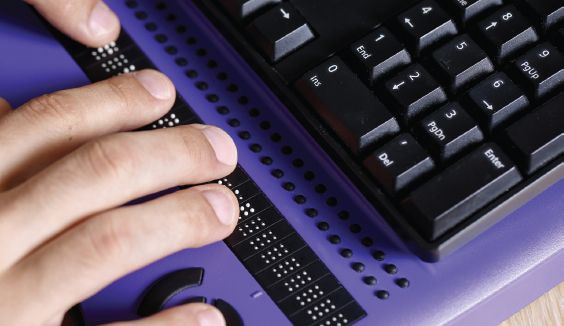
Braille printers can be used to aid visually impaired users by printing the raised patterns of dots on special paper, thereby allowing them to read the text with their fingers.
 Activity 6.1
Activity 6.1
1.Multiple choice:
a.Stephen Hawking was diagnosed with?
A.ALS
B.ADHD
C.CTS
D.Parkinson’s disease
b.Which of the following is NOT a device for the physically challenged?
A.Microphones
B.On-screen or virtual keyboards
C.Monitor
D.Keyguards
2.Match Column B with Column A:
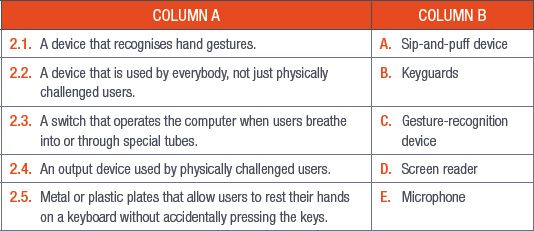
3.Write True or False next to the question number. Correct the statement if it is FALSE. Change the underlined word(s) to make the statement TRUE. (You may not simply use the word NOT to change the statement.)
a.Braille interfaces are for deaf people.
b.The Paste keyboard shortcut uses the Ctrl + P keys.
c.Sighted users may not be able to use screen readers.
4.List the advantages and disadvantage of the following devices:
a.On-screen or virtual keyboards
b.Braille keyboards
c.Head-mounted pointers
d.Gesture-recognition devices
e.Sip-and-puff devices
UNIT
6.2 Health issues due to input and output devices
With more and more people using computers in their daily lives, certain health issues surrounding computer use have come up in recent years. Some of these have to do with the impact that using a computer has on your body, for example, repetitive strain injuries (RSIs) to wrists and back and eye strain from bad posture and lighting.
This section looks at how to prevent these health issues to make sure that you stay healthy.
ERGONOMICS
Ergonomics is concerned with how to design/arrange furniture and equipment in a way that will make people more comfortable and efficient in their work. It also looks at how people interact with their input and output devices to minimise the amount of physical strain placed on their bodies. Therefore, ergonomically designed computer mice, keyboards, desks and chairs have been developed to reduce RSIs, carpal tunnel syndrome and back strain.
Ergonomics also determine how people should sit (their posture), how they should look at a screen and how often they should get up.
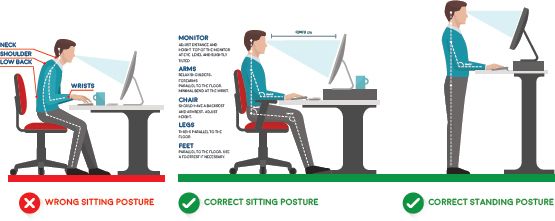
When you want to reduce the amount of strain on your body, remember to do the following:
- Make sure that your desk, chair and screen are all at a comfortable height.
- Sit properly and do not slouch or hunch your shoulders. This could cause backache and neck pain.
- Stand up and move around at least once an hour. Try using a standing desk (if possible) for some of the time you are working.
- Never bend your neck to look at your screen. Always make sure that your chin is parallel to your desktop.
- Make sure your shoulders are relaxed when you are typing (not raised or hunched), your knees are at a 90° angle and your feet are flat. If you are too short for your feet to touch the floor and have your arms at a comfortable angle, find a footrest to put your feet on.
- Make sure your back and hips are in contact with the back of the chair you are sitting on and that the chair has good back support.

COMPUTER ERGONOMICS
Computer and smartphone screens can be set to have less blue light, lessening the glare and reducing eye strain. They can also be tilted until you find a comfortable viewing angle.
 Activity 6.2
Activity 6.2
1.Multiple choice:
a.Which of the following equipment does not carry a lot of germs?
A.Smartphones
B.Computer mice
C.Keyboards
D.Monitors
b.Which one of the following is not an effect of sitting for too long in front of a computer?
A.Obesity
B.Increased blood pressure
C.Hair loss
D.High blood sugar
c.Which of the following is not an injury due to improper ergonomics?
A.Repetitive strain injury
B.Computer vision syndrome
C.Repetitive strain injury
D.Back strain
2.Write True or False next to the question number. Correct the statement if it is FALSE. Change the underlined word(s) to make the statement TRUE. (You may not simply use the word NOT to change the statement.)
a.Repetitive strain injuries and eye strain are examples of health issues due to input and output devices.
b.Hardware needs to be protected from theft and damage.
c.Computer and smartphone screens can be set to have less red light, lessening the glare and reducing eye strain.
d.You will have good back support when you place your hips and back on the back of the chair.
3.Answer the following questions in your own words:
a.Define ergonomics.
b.List two ways that you can keep your hardware clean and hygienic.
c.List three ways that you can reduce the amount of strain on your body.
UNIT
6.3 Protecting your hardware
Knowing how to protect your hardware so that it carries on working correctly is as important as knowing what hardware is used for and the health risks associated with using input and output devices. This unit looks at protecting your hardware from theft, damage and power surges. You will also learn about the optimal power settings for your devices and how your devices can contribute to energy savings.
HARDWARE PROTECTION
Hardware needs to be protected from two major things, namely theft and damage. Because your hardware is expensive and sensitive equipment, you must make sure that you do your best to keep it safe and in good working condition for as long as possible.
To protect your hardware from theft, you can do the following:
- Use locking cables attached to walls or hard-to-move desks to lock items such as monitors into place. Use lockable cages or boxes for things such as computer cases and servers.
- Invest in lockable docking stations for laptops. These docks lock as soon as you click a laptop into place, keeping your laptop safe from theft.
- Always be alert and aware of your surroundings when using mobile computing devices such as smartphones and tablets.
To protect your hardware from everyday wear and tear, you should keep the following in mind:
- Always use a screen protector and case for smartphones and tablets.
- Avoid spilling liquids on keyboards and mice.
- Make sure that any device drivers you need are up to date and correctly installed.

 Activity 6.3
Activity 6.3
1.Answer the following questions in your own words:
a.List four ways that you can protect your hardware from theft.
b.Give three examples of ways to protect your hardware devices from damage.
UNIT
6.4 Power supply and settings
Each piece of hardware you use will need to draw on some kind of power to operate, whether it is plugged directly into a power supply (such as monitors and desktop computers), operates with batteries (such as most wireless devices and smartphones, tablets and laptops), or draws power from the computer it is plugged into (such as wired keyboards and mice).
Computers and their associated hardware are some of the largest consumers of power in the home and workplace. By learning how to set these devices so that they use the minimum amount of power needed to operate effectively, and by purchasing devices that have a low energy consumption, you can reduce the amount of power your computer consumes.
Most displays and touchscreens can be adjusted to consume less power. You can do this by adjusting the brightness of your display until it is at a comfortable level. Most screens have a button on the bottom right-hand corner to turn the brightness up or down. Laptops usually have brightness keys on the keyboard and smartphones and tablets can be adjusted by going into the display settings.
You should adjust your screen brightness to suit the area, time of day and lighting. Even lowering the brightness by a small amount can save power and limit the strain you put on your eyes.
When you buy new hardware, you should look for devices that have an Energy Star rating. Devices with an Energy Star rating are usually more energy efficient, meaning they use less energy to perform the same tasks as devices that are not rated.
HOW TO PROTECT YOUR DEVICES FROM POWER FAILURES
Uninterruptible power supplies (UPSs) can protect your devices from unexpected power failures and even power surges. UPSs are plugged directly into the main power supply to charge their batteries and will immediately start providing power to the computers connected to them in the case of a power failure.
 Activity 6.4
Activity 6.4
1.Write True or False next to the question number. Correct the statement if it is FALSE. Change the underlined word(s) to make the statement TRUE. (You may not simply use the word NOT to change the statement.)
a.Devices with an Energy Star rating are usually more energy efficient.
b.All the data on your hard drive will be lost in case of a power failure.
c.Your display should never be brighter or darker than the area you are using it in.
2.Answer the following questions in your own words:
a.Describe a UPS.
b.Explain how you would protect your device from power failure.
REVISION ACTIVITY
QUESTION 1: MULTIPLE CHOICE
1.1Which of the following is an output device for physically challenged computer users? (1)
A.Gesture-recognition software
B.Braille interfaces
C.Sip-and-puff devices
D.Braille keyboards
1.2What is an advantage of a keyguard? (1)
A.It reduces the number of typing errors.
B.It does have a universal standard for its keyboard.
C.It can be operated with multiple input devices.
D.It can be used with speech-recognition software.
1.3Text-to-speech software can be used by which of the following output devices? (1)
A.Monitor
B.Keyboard
C.Printer
D.Speaker
1.4Ergonomics does not involve ________. (1)
A.Making sure people are in a comfortable position
B.Arranging furniture and equipment
C.Reducing strain on the human body
D.Adjusting the lighting of an area
1.5Which of the following will not reduce your computer’s power usage? (1)
A.Unplugging your computer when you are not using it
B.Reducing the brightness of your display
C.Buying hardware with an Energy Star rating
D.Reducing your CPU’s speed
QUESTION 2: TRUE OR FALSE
Write True or False next to the question number. Correct the statement if it is FALSE. Change the underlined word(s) to make the statement TRUE. (You may not simply use the word NOT to change the statement.)
a.An eye-motion sensor is activated when a user breathes into its special tubes. (1)
b.A foot-operated mouse can be used by people who are blind. (1)
c.Text-to-speech software uses microphones. (1)
d.The interaction between the human body and computing hardware refers to economics. (1)
e.Looking at a computer monitor for a long time can damage your sight. (1)
QUESTION 3: MATCHING ITEMS
3.1Choose a term/concept from Column B that matches a description in Column A. Write only the letter next to the question number (e.g. 1J). (5)
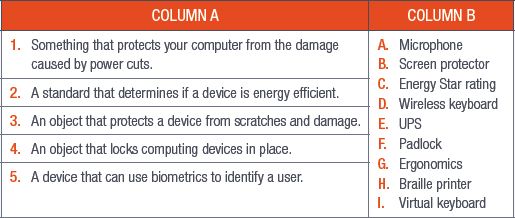
QUESTION 4: SCENARIO-BASED QUESTIONS
Mr Riaad is a primary school teacher who teaches eight and nine-year-olds. He wants to teach them how to use computers safely. Since they will be using the computers a lot, he is also concerned about their eyesight.
4.1Mention two devices that Mr Riaad’s learners can use to improve their interaction with computers. Give a reason for each of your answers. (4)
4.2Mention one way his learners may not benefit from using each of these devices. (2)
4.3Mention three things Mr Riaad`s learners can do to reduce the strain on their eyes. (3)
4.4One of his learners has been struggling to see the letters on her keyboard. Suggest two alternative input methods that she could use. (2)
4.5A head-mounted pointer is an input device for phisically challenged users.
a.Explain how a head-mounted pointer is operated. (2)
b.Give two disadvantages of using a head-mounted pointer. (2)
4.6Mr Riaad must travel a lot. Name three things he can do to protect his smartphone and laptop while travelling. (3)
4.7Mr Riaad often uses trains to travel from one place to another. During this time, he uses his laptop to complete some of his work. Provide four tips he can use to reduce the strain on his body. (4)
4.8List three ways that Mr Riaad can teach his learners to save energy. (3)
TOTAL: [40]
AT THE END OF THE CHAPTER

|
Previous
Chapter 5: Hardware, software and computer management
|
Table of Contents |
Next
Chapter 7: Networks and internet technologies
|


